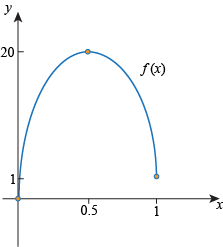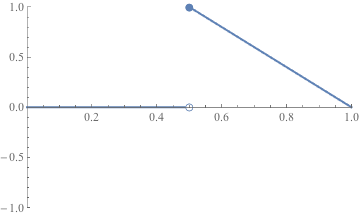Example 1
- Can we use the IVT to conclude that f(x) = x3 + 2x + 1 passes through y = 0 on the interval (-2, 2)?
Example 2
- Can we use the IVT to conclude that f(x) = ex passes through y = 0.1 on the interval (0, 1)?
Example 3
- Can we use the IVT to conclude that f(x) = sin(x) equals 0.4 at some place in the interval
 ?
?
Example 4
- Can we use the IVT to conclude that f(x) = tan(x) equals 0 for some c in (0, π)?
Example 5
- Can we use the IVT to conclude that f(x) = x2 passes through 1 on the interval (-1, 1)?
Example 6
- Draw a function that is continuous on [0, 1] with f(0) = 0, f(1) = 1, and f(0.5) = 20.
Example 7
- Suppose that f hits every value between y = 0 and y = 1 on the interval [0, 1]. Must f be continuous on that interval?

 . With
. With  and f(b) = sin(π) = 0. Since f(b) = 0 < 0.4 < 1 = f(a), the IVT says there is some c in
and f(b) = sin(π) = 0. Since f(b) = 0 < 0.4 < 1 = f(a), the IVT says there is some c in  with f(c) = 0.4.
with f(c) = 0.4.
